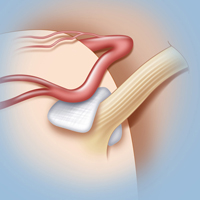
In the procedure called microvascular decompression, a neurosurgeon lifts a blood vessel off the nerve it's compressing, then inserts a small pad between the vessel and the nerve to relieve the pressure.
Surgery for hemifacial spasm is a procedure called microvascular decompression. Unlike injections of botulinum toxin (Botox injections), surgery for hemifacial spasm is effective in 85 percent of cases and is a permanent solution that leads to lasting relief of symptoms.
The goal of this surgical procedure is to reposition the artery that irritates the nerve as it comes out of the brainstem, stopping the spasms at their source. Microvascular decompression is a type of advanced microsurgery that should be performed by an experienced neurosurgeon (see Doctors Who Treat Hemifacial Spasm).
In a microvascular decompression, which is performed under general anesthesia, the neurosurgeon makes a small incision behind the ear and then a small opening (about one inch) in the skull. This allows the surgeon to see the small blood vessel that is pressing on the facial nerve. Once the surgeon locates the site of the compression, the blood vessel is lifted away from the nerve.
The surgeon inserts a tiny pad on the nerve to prevent further contact with the blood vessel, then closes the incision. It is very important that an experienced surgeon perform this procedure — there is often more than one blood vessel pressing on the nerve, and it’s important to locate and repair all of them in order to stop the spasms.
Recovery from this procedure is brief — most patients can be discharged from the hospital two or three days after surgery. Most patients experience an end to the tics immediately, although some individuals have lessening symptoms over the course of a week or more before the spasms stop completely. The majority of patients who have this procedure performed by a qualified neurosurgeon have no further facial tics and require no further medications.
Some patients report mild facial weakness after the surgery, but it is invariably temporary. Serious complications of hemifacial spasm surgery are rare, with some slight ore permanent hearing loss on the affected side reported in a small number of patients. Symptoms rarely come back when the surgery is performed by an experienced neurosurgeon with expertise in hemifacial spasm, making the choice of surgeon extremely important.
Microvascular decompression is a very safe procedure with a history of good outcomes when performed by a qualified neurosurgeon. The procedure should only be conducted in a major medical center with highly skilled neurosurgeons and neurologists. The neurosurgeons and neurologists the Weill Cornell Brain and Spine Center are highly skilled in this technique.
Reviewed by: Philip E. Stieg, PhD, MD
Last reviewed/last updated: April 2021
Illustration by Thom Graves, CMI